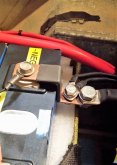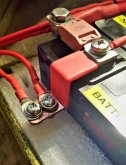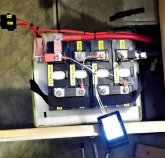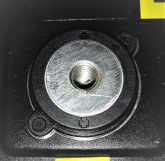I'm wondering if anyone has experience using aluminum lifepo4 cells in a mobile context, where road vibration, bumps, etc, are a factor. I'm especially curious whether anyone has used these cells in an overland build? How do they hold up? How does the quality of construction seem overall?
You are using an out of date browser. It may not display this or other websites correctly.
You should upgrade or use an alternative browser.
You should upgrade or use an alternative browser.
Who has experience with (blue) aluminum cells in a mobile system?
- Thread starter Dzl
- Start date
Stupid Monkey
New Member
- Joined
- Dec 14, 2019
- Messages
- 193
No experience, but going that way and have researched. Cell compression is important, in boats they advise rear of boat for less shocks. I'm not sure the best way to reduce shocks in travel in a RV, and if off roading and overlanding again packaging of the battery would be something I'd want to research. Might be better with hard plastic cases but I'm very new to all this and could be missing lots of info.
No experience, but going that way and have researched. Cell compression is important, in boats they advise rear of boat for less shocks. I'm not sure the best way to reduce shocks in travel in a RV, and if off roading and overlanding again packaging of the battery would be something I'd want to research. Might be better with hard plastic cases but I'm very new to all this and could be missing lots of info.
New or not, I appreciate the input, thanks!
edit: I'm looking at the same batteries from the same seller as you you also.
Last edited:
Consensus seems to be that the Al cells, while smaller and lighter, are not the best choice for off-road apps. Those tiny terminals, compared to bulkier plastic-housed cells, are spot welded and get hot. Terminals on Calbs, for example, are actually part of the casing and will hold up better in mobile applications.
Consensus seems to be that the Al cells, while smaller and lighter, are not the best choice for off-road apps. Those tiny terminals, compared to bulkier plastic-housed cells, are spot welded and get hot. Terminals on Calbs, for example, are actually part of the casing and will hold up better in mobile applications.
Thank you this is helpful information!
Those tiny terminals, compared to bulkier plastic-housed cells, are spot welded and get hot. Terminals on CALBs, for example, are actually part of the casing and will hold up better in mobile applications.
Okay, now I have to over-complicate things. I wonder how durable the CALB Aluminum cells are. I didn't realize they made an aluminum cell until today.
Ah are you sure about that? (the weight loss alone would be the target for the EV crowd)
Yeah I was thinking the same. On the other hand, a lot more goes into 'engineering' the lithium battery setup in a production EV that is outside the scope of what most DIYers can do. I'm thinking custom enclosures, vibration damping, compression, heat dissipation, that kind of thing. Also, I'm not sure any lifepo4 are designed for EV use, so there may be differences in build quality between Aluminum lifepo4 cells and other lithium chemistries. Just thinking out loud hear, you make a good point that is worth further consideration.
Solarfun4jim
Solar seduced :-)
I think the rule of thumb(for mobile) is dont go above 200AH cells and preferably only 100AH cells which are structurally stronger internally. I was wondering about a layer of 25mm kingspan insulation around each cell side, a temp controlled glass plate on the bottom and a fan to control above cell ambient air temperature.
Need to consider emergency braking deceleration forces??
Need to consider emergency braking deceleration forces??
grizzzman
Photon Vampire
- Joined
- Sep 21, 2019
- Messages
- 2,755
"A sales manager at Sinopoly I was talking to was adamant about using 100Ah or 200Ah cells only for assembling marine battery banks, with 100Ah being preferred and 200Ah acceptable. Large cells simply don’t have the structural strength-to-weight ratio required to be taken to sea on board small crafts and would exhibit shortened life due to internal mechanical damage arising from on-going vessel motion. It is common sense: as a cell becomes larger, its internal weight increases much faster than the rigidity and surface area of the casing and the casing is all what holds the plates together in a prismatic cell. "
This is from Nordkyndesign. (About plastic prismatic cells) An aluminum cell was cut open by a member here. The construction appears to be much more robust.)
This is from Nordkyndesign. (About plastic prismatic cells) An aluminum cell was cut open by a member here. The construction appears to be much more robust.)
One thing that jumps out at me is that those generic labels say one thing but the data sheet on the listing says another: Are they 190Ah or 180? Might do well to watch this vid Will posted last week.Okay, now I have to over-complicate things. I wonder how durable the CALB Aluminum cells are. I didn't realize they made an aluminum cell until today.
Two reasons I'm going with the plastic CALBs: 1. Can't easily fake the branding that's baked into the housing, and 2. I know these have been around a long time and do well in off road applications.
There may be some good Al-cased LiFePO4's out there, maybe even ones that would hold up off-road given the proper mounting. If I had $$ to burn I might give 'em a go and let y'all know ... alas, I don't, so I'm going with what I know will work vs what might or might not.
I'm trying to put 200ah 12v in a tight space in a van. I would love to see your battery box and bms setup. This battery has no reviews online, but seems like a very good fit for my design: https://www.aliexpress.com/item/330...&terminal_id=6c842a8bc967466e8b96269aab5fd31c I really can't find a good bms for this design either. Any thoughts, pics, redirects???
Stupid Monkey
New Member
- Joined
- Dec 14, 2019
- Messages
- 193
these are on Will's site https://www.mobile-solarpower.com/raw-lifepo4-deals-page.htmlI'm trying to put 200ah 12v in a tight space in a van. I would love to see your battery box and bms setup. This battery has no reviews online, but seems like a very good fit for my design: https://www.aliexpress.com/item/330...&terminal_id=6c842a8bc967466e8b96269aab5fd31c I really can't find a good bms for this design either. Any thoughts, pics, redirects???
and he's just reviewed a bms too https://diysolarforum.com/threads/f...low-temp-charging-protection.2884/#post-27128
Stupid Monkey
New Member
- Joined
- Dec 14, 2019
- Messages
- 193
There's places to solder additional large wires I'm.sure i read ..... or heard. Hes a full review video coming very soon..... but for the skinny little 10 gauge wires.
grizzzman
Photon Vampire
- Joined
- Sep 21, 2019
- Messages
- 2,755
These look like used cells..... "buyer beware"I'm trying to put 200ah 12v in a tight space in a van. I would love to see your battery box and bms setup. This battery has no reviews online, but seems like a very good fit for my design: https://www.aliexpress.com/item/330...&terminal_id=6c842a8bc967466e8b96269aab5fd31c I really can't find a good bms for this design either. Any thoughts, pics, redirects???
Tex
New Member
- Joined
- Dec 16, 2019
- Messages
- 83
Hi Guys, In regard to LiFePO4 batteries in RV's I can provide the following advice.
I installed a "Vision" 100 amp Hr LiFePO4 mono cell in our caravan 4 years ago along with a Victron 75/15 Regulator, 2 x 195 watt panels, a Victron Smart Charger, and a Latronics 1500 watt inverter.
Dragged the whole lot around Oz for about 22,000 Klm's (just the West side), over many miles of really bad corrugations, no issues.
Problem was the battery output maxed out at 50 amps, so wouldn't run the microwave or coffee pod machine.
I have just upgraded to 4 x 200 amp aluminium case prismatic cells from Shenzhen RJ Energy Co. Ltd, a Daly 3 port 200 amp BMS.
I have put the 4 cells in a rotor molded plastic box I had, together with most of the foam the batteries came pack in (see pics), there is also foam under the cells, and under the box. This fits perfectly beside the inner wheel arch and the seat frame, and is held in place by 2 pieces of timber screwed to the floor either side. The inverter is under one of the two single beds, with a rotation polycarbonate cover for easy access to the switch.
Unfortunately the BMS I received was DOA, and has been sent back. The batteries are actually marked 210 amp hours, and seem to be very good.
I also bought one of the ISDT BG-8S balancers which Will reviewed which works a treat ( but slow on big batteries).
As I have stated elsewhere, (and mentioned by Will yesterday) with all the buggering around trying to work out what was wrong with the BMS, and testing for Daly tech's must have undone and re tightened the two main terminals about 30 times! End result was a stripped thread on the total negative, I repaired it with a helicoil, and today I did the main positive as well (much better job). unfortunately you can't remove the tang from a blind hole, but it is a far stronger than original (see pics) Those 6 mm. )by about 10mm. deep) terminals are ridiculously small.
Yesterday I ordered 10 of these studs to replace all the bolts currently fitted: https://tinyurl.com/qsbqbgo
Because the ISDT BG-8S balancer has a programmable low voltage alarm, and I might have to wait 3 or 4 weeks to receive the replacement BMS, I decided to test the batteries without the BMS, keeping a close eye on the individual cell voltages via the ISDT BG-8S balancer (not in balance mode, just voltage).
After installing the battery with home made bus bars and fusing etc. I ran the microwave for 3 minutes at full whack, (about 1100 watts), no discernible battery drop, then made two cups of coffee (Aldi machine) draws about 1500 watts (inverter max). no discernible battery drop.
As I recently also bought a two burner (Aldi) induction cook top, I decided to give that a run. I ran it outside the van on an extension lead with a watt meter connected to the lead. The cooktop has power setting from 1 to 10, (or max 5 on both at once. any setting up to 6 cycles on and off like a microwave, 6 is pretty steady at about 1050 watts, 7 seven seems to be the max at 1350 watts, and 8 jumps to 1600 watts (but still ran ok for about 30 seconds till I switched back to 7. Boiled a large pot of water over about 6 or 7 minutes, all cells still sitting around 3.232 to 3.245 under load, (the battery was not fully charged prior to test). None of the bus bars leads or batteries got the even slightest bit warm either. BTW the two smaller wires on the bus bars are the solar cable and the other one is the shower pump.
As per my schematic I am also going to add a small Victron Battery disconnect on the ELV side because we also run ELV lights when we are not running the inverter for bigger loads if free camping. I don't think I actually need the 250 amp relay I bought because the 200 amp BMS should handle all my loads easily.
End result? Happy Camper!
Problem now is our next holiday was to be right up the east cost to Cooktown, half the bloody country has just burnt to the ground, massive property loss, many deaths, huge wildlife loss, huge evacuations of locals and campers, and it's still going on. So we will have to wait until things are on the mend.
Hope this info is of some use, to somebody.
Cheers
Tex
I installed a "Vision" 100 amp Hr LiFePO4 mono cell in our caravan 4 years ago along with a Victron 75/15 Regulator, 2 x 195 watt panels, a Victron Smart Charger, and a Latronics 1500 watt inverter.
Dragged the whole lot around Oz for about 22,000 Klm's (just the West side), over many miles of really bad corrugations, no issues.
Problem was the battery output maxed out at 50 amps, so wouldn't run the microwave or coffee pod machine.
I have just upgraded to 4 x 200 amp aluminium case prismatic cells from Shenzhen RJ Energy Co. Ltd, a Daly 3 port 200 amp BMS.
I have put the 4 cells in a rotor molded plastic box I had, together with most of the foam the batteries came pack in (see pics), there is also foam under the cells, and under the box. This fits perfectly beside the inner wheel arch and the seat frame, and is held in place by 2 pieces of timber screwed to the floor either side. The inverter is under one of the two single beds, with a rotation polycarbonate cover for easy access to the switch.
Unfortunately the BMS I received was DOA, and has been sent back. The batteries are actually marked 210 amp hours, and seem to be very good.
I also bought one of the ISDT BG-8S balancers which Will reviewed which works a treat ( but slow on big batteries).
As I have stated elsewhere, (and mentioned by Will yesterday) with all the buggering around trying to work out what was wrong with the BMS, and testing for Daly tech's must have undone and re tightened the two main terminals about 30 times! End result was a stripped thread on the total negative, I repaired it with a helicoil, and today I did the main positive as well (much better job). unfortunately you can't remove the tang from a blind hole, but it is a far stronger than original (see pics) Those 6 mm. )by about 10mm. deep) terminals are ridiculously small.
Yesterday I ordered 10 of these studs to replace all the bolts currently fitted: https://tinyurl.com/qsbqbgo
Because the ISDT BG-8S balancer has a programmable low voltage alarm, and I might have to wait 3 or 4 weeks to receive the replacement BMS, I decided to test the batteries without the BMS, keeping a close eye on the individual cell voltages via the ISDT BG-8S balancer (not in balance mode, just voltage).
After installing the battery with home made bus bars and fusing etc. I ran the microwave for 3 minutes at full whack, (about 1100 watts), no discernible battery drop, then made two cups of coffee (Aldi machine) draws about 1500 watts (inverter max). no discernible battery drop.
As I recently also bought a two burner (Aldi) induction cook top, I decided to give that a run. I ran it outside the van on an extension lead with a watt meter connected to the lead. The cooktop has power setting from 1 to 10, (or max 5 on both at once. any setting up to 6 cycles on and off like a microwave, 6 is pretty steady at about 1050 watts, 7 seven seems to be the max at 1350 watts, and 8 jumps to 1600 watts (but still ran ok for about 30 seconds till I switched back to 7. Boiled a large pot of water over about 6 or 7 minutes, all cells still sitting around 3.232 to 3.245 under load, (the battery was not fully charged prior to test). None of the bus bars leads or batteries got the even slightest bit warm either. BTW the two smaller wires on the bus bars are the solar cable and the other one is the shower pump.
As per my schematic I am also going to add a small Victron Battery disconnect on the ELV side because we also run ELV lights when we are not running the inverter for bigger loads if free camping. I don't think I actually need the 250 amp relay I bought because the 200 amp BMS should handle all my loads easily.
End result? Happy Camper!
Problem now is our next holiday was to be right up the east cost to Cooktown, half the bloody country has just burnt to the ground, massive property loss, many deaths, huge wildlife loss, huge evacuations of locals and campers, and it's still going on. So we will have to wait until things are on the mend.
Hope this info is of some use, to somebody.
Cheers
Tex
Attachments
-
 Busbars (1).jpg115 KB · Views: 187
Busbars (1).jpg115 KB · Views: 187 -
 Busbars (2).jpg121.6 KB · Views: 189
Busbars (2).jpg121.6 KB · Views: 189 -
 Caravan battery installation.jpg116.8 KB · Views: 208
Caravan battery installation.jpg116.8 KB · Views: 208 -
 Installed LiFePO4 (1).jpg95.7 KB · Views: 214
Installed LiFePO4 (1).jpg95.7 KB · Views: 214 -
 Installed LiFePO4 (2).jpg66.7 KB · Views: 218
Installed LiFePO4 (2).jpg66.7 KB · Views: 218 -
 Prismatic cell battery box.jpg121.9 KB · Views: 216
Prismatic cell battery box.jpg121.9 KB · Views: 216 -
 Regulator & Bluetooth (3).jpg57 KB · Views: 210
Regulator & Bluetooth (3).jpg57 KB · Views: 210 -
 Victron Smart charger.jpg86.1 KB · Views: 191
Victron Smart charger.jpg86.1 KB · Views: 191 -
 Helicoil insert.jpg148.8 KB · Views: 184
Helicoil insert.jpg148.8 KB · Views: 184 -
New LiFePO4 & BMS connections (with BP on ELV only)..pdf137 KB · Views: 46
Last edited:
Similar threads
- Replies
- 9
- Views
- 363
- Replies
- 22
- Views
- 1K
- Replies
- 48
- Views
- 3K


